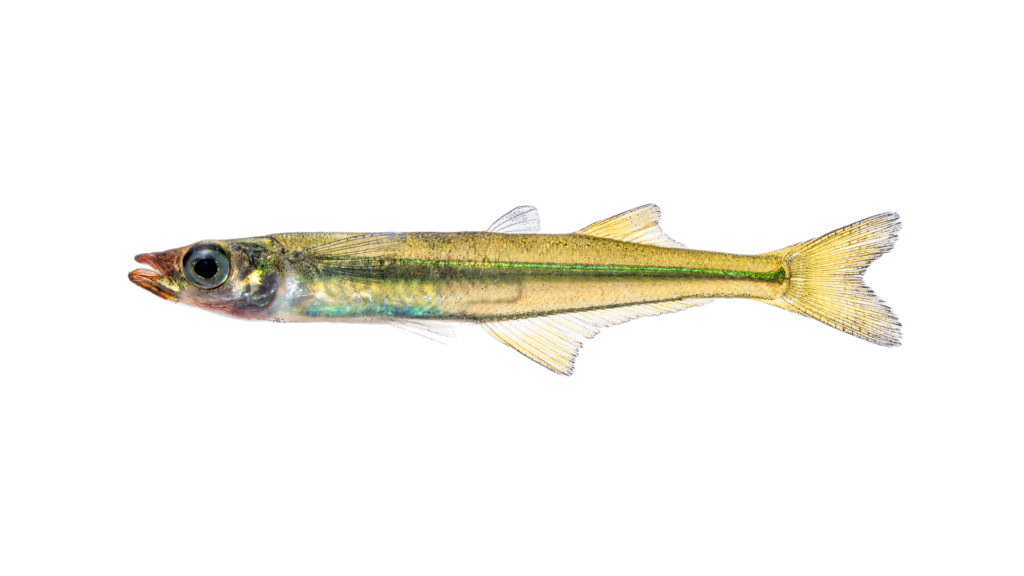By the NCFishes.com Team
Atherinopsidae is a small family comprising six species in North Carolina (Table 1). The common name, silversides, refers to a distinct silver stripe on the side, which often reflects sunlight like a mirror when these fishes turn near the water surface (Rohde et al. 2009). Silversides are generally delicate, slender, laterally compressed, and translucent (Rohde et al. 2009). Maximum length is approximately 125 mm (5 inches) and most silversides live only one year.
Table 1. Species of New World silversides found in or along the coast of North Carolina.| Scientific Name/ American Fisheries Society Accepted Common Name | Scientific Name/ American Fisheries Society Accepted Common Name |
|---|---|
| Labidesthes sicculus - Brook Silverside | Menidia beryllina - Inland Silverside |
| Labidesthes vanhyningi - Southern Brook Silverside | Menidia extensa - Waccamaw Silverside |
| Membras martinica - Rough Silverside | Menidia menidia - Atlantic Silverside |
Waccamaw Silverside is often referred to as skipjack or glass minnow because of its translucency. But as we have learned, each species has its own scientific (Latin) name which actually means something (please refer to The Meanings of the Scientific Names of Silversides, page 10) along with an American Fisheries Society-accepted common name (Table 1; Page et al. 2013).

Silversides may be found from Hot Springs in Madison County to Hatteras Village in Dare County (Maps 1-6) occurring in fresh and salt water environments, but are most abundant inhabiting our coastal rivers, estuaries, and offshore (Tracy et al. 2020; NCFishes.com [Please note: Tracy et al. (2020) may be downloaded for free at: https://trace.tennessee.edu/sfcproceedings/vol1/iss60/1.]
Rough Silverside, Inland Silverside, and Atlantic Silverside are found along the coast (Maps 3-6), but Inland Silverside has also been found as far upstream as near Elizabethtown (Cape Fear basin), near Greenville (Tar basin), and near Murfreesboro on the Meherrin River (Chowan basin) and was recently found in Lake Norman (Tracy et al. 2020; Map 4). [Note: see Supplemental Maps 1-3, page 11, showing North Carolina’s 100 counties, 21 river basins, and 4 physiographic regions.] The Waccamaw Silverside is endemic to Lake Waccamaw, Columbus County and is found nowhere else in the world. It was described by Hubbs and Raney in 1946. Because of its limited distribution and potential anthropogenic impacts upon its habitat and water quality, Waccamaw Silverside is listed as Federally Threatened (Krabbenhoft et al. 2005; NCAC 2017; NCNHP 2020; NCWRC 2017).
Until 1995 no species of Labidesthes were known to occur in North Carolina. Southern Brook Silverside is a recent, natural, immigrant to North Carolina from South Carolina. It was first discovered in North Carolina in 1995 in the Waccamaw River, Waccamaw basin (Moser et al. 1998). Since then, it has naturally dispersed into Lake Waccamaw, where it now co-occurs with the Waccamaw Silverside, in the Waccamaw River, and throughout the Lumber, lower Yadkin, and lower Cape Fear basins (Map 1). In North Carolina, Southern Brook Silverside is now at the northern limit of its range along the Atlantic slope in North Carolina (Werneke and Armbruster 2015).

Similar to Southern Brook Silverside, Brook Silverside is also a recent, natural, immigrant to North Carolina after swimming upstream from Tennessee. It was first discovered in North Carolina in 2012 by North Carolina Wildlife Resources Commission staff in the mainstem of the lower French Broad River in Madison County, French Broad basin (Tracy et al. 2020). So far, this is it only known occurrence in the state (Map 2).

The identification of silversides is relatively straight-forward. Key characteristics for their proper identification include the shape of the snout; scale textures; positioning of the origin of the spinous dorsal fin in relation to the origin of the anal fin; the number of anal fin rays; and their geographical distribution (please refer to the Identification Key to the Species of New World Silversides (Family Atherinopsidae) in North Carolina. However, several species can co-occur within the same habitats at the same time, such as Inland Silverside and Atlantic Silverside, rendering field identifications a challenge.
If you have troubles with your identifications, just send us (https://ncfishes.com/contact/) an e-mail and include as many quality digital photographs as you can along with all the pertinent locality descriptors so that we will know from where the fish came.